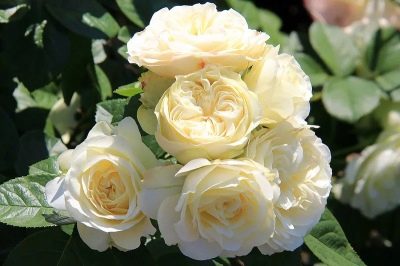
- Authors: Robert Laperriere
- Name synonyms: Winter Lodge, LAPwin, Uinte Lodge
- Breeding year: 2010
- Group: scrub, bush
- The main color of the flower: white
- Flower shape: flattened to rosette
- Flower size: large
- Diameter, cm: 8-10
- Flower type by number of petals: thick double
- Scent: with notes of anise and leather
Among spray roses, Winter Lodge is very popular. These flowers have unique decorative qualities in their own way, they are easy to care for, since they are not too demanding.
Breeding history of the variety
Winter Lodge was brought from France in 2010; it was from this period that the flower was entered in the State Register of the Russian Federation. The variety belongs to bush, intended for planting as one plant, and in groups of several bushes.
Description of the variety
Winter Lodge's buds are creamy white with a slightly distinct green tint. When the flowers bloom, they become just creamy, the color intensity is weak.
The buds are cone-shaped, the flowers of this rose can be flat-bowl or rosette-shaped in shape. It is a shrub with large flowers, some even up to 100 mm in diameter. Winter Lodge is a densely doubled variety, up to 100 petals are formed on one bud.
Only one flower can form on one stem, or maybe three at once. Winter Lodge has a weak aroma with a slight hint of anise.
The bushes of this variety grow no more than 1 meter, the crown width can reach 70 cm. Very beautiful foliage at Winter Lodge, which has a bright green tint. The glossy surface adds charm to the plant.
Advantages and disadvantages
One of the main advantages of the Winter Lodge variety is its decorative qualities. Large double flowers look gorgeous in any flower bed. This flower can grow normally in partial shade, but it has medium resistance to rainfall and requires shelter for the winter.
Flowering features
Winter Lodge blooms throughout the season and is very abundant, which pleases domestic gardeners. It is a continuous flowering rose.
Use in landscape design
Most often, a rose of this variety is used in single plantings and in groups. She takes a worthy place in rosaries around the world.
Landing
When planting roses of this variety, it is better to use fertile soil. Prepare it yourself: 2 buckets of garden soil, 1 bucket of rotted manure, 1 bucket of peat, 1-2 buckets of sand and clay soil.
For Winter Lodge roses, another soil mixture is also suitable: 1-2 buckets of sandy soil, 2 cups of bone meal, 1-2 pinches of superphosphate. You can add 1-2 cups of dolomite flour. Everything is thoroughly mixed and the resulting mixture is filled into a pit.
If the soil on the site where you plan to create a rose garden with Winter Lodge is fertile, you need to dig it up twice to saturate it with oxygen. A planting pit 50x50x50 cm in size is suitable for the bushes of this flower. The main thing to remember is that the root system must completely sink to the bottom of the pit. To remove excess moisture, a drainage layer of small pebbles or expanded clay is mandatory, sometimes broken brick is used.
Growing and caring
This rose loves the sun, so it feels great outdoors. The best option is a place where the flower will remain in partial shade for some time. 5-6 hours a day under the sun is enough for Winter Lodge to develop normally.
After planting, the bushes of Winter Lodge are best sprayed, as well as the ground around them.A good solution would be preparations with a copper content ("Fundazol" - 0.5%, copper oxychloride - 0.5%, copper sulfate - 0.5%), since pests and spores of fungal diseases can be found in the ground.
To maintain moisture near the roots of Winter Lodge shrubs during dry summers, you will need to cover the tree trunk with mulch. The diameter should be about 50 cm around the bush. The role of mulch can be played by straw, sawdust, or even simple dry foliage.
Watering and feeding
It is worth watering Winter Lodge as the soil dries up, but do not overflow, as root rot may begin. Up to 5 liters of liquid is enough for one bush every two days if there is no precipitation.
As a top dressing, it is better to use organic matter in the form of compost or rotted manure. Of the mineral complexes, it is advised to use formulations with potassium, magnesium, nitrogen for Winter Lodge. The first top dressing is applied in the spring, then more nitrogen is added. During the period of the appearance of buds, funds are used with other, no less important microelements, and during the flowering period and in the fall, no feeding is applied.
Pruning
Pruning Winter Lodge requires regular pruning. In the spring, sanitization of the bushes that survived the winter is carried out. Old and diseased shoots are cut off twice, the first - immediately after the appearance of the buds, the second time - after the formation of foliage.
In the summer, faded buds should be removed from the bushes of Winter Lodge so that they do not spoil the appearance of the flower bed.
Frost resistance and preparation for winter
The frost resistance zone at Winter Lodge is 6, that is, the variety can withstand up to -23 ° C. Despite this, it is better for young bushes to provide shelter from burlap or even just old foliage and spruce branches for the winter.
Diseases and pests
A feature of the described variety is excellent immunity to diseases and pests. As a preventive measure, you can simply treat the bushes with a solution of potassium permanganate in the spring or garlic infusion to scare off aphids.































































